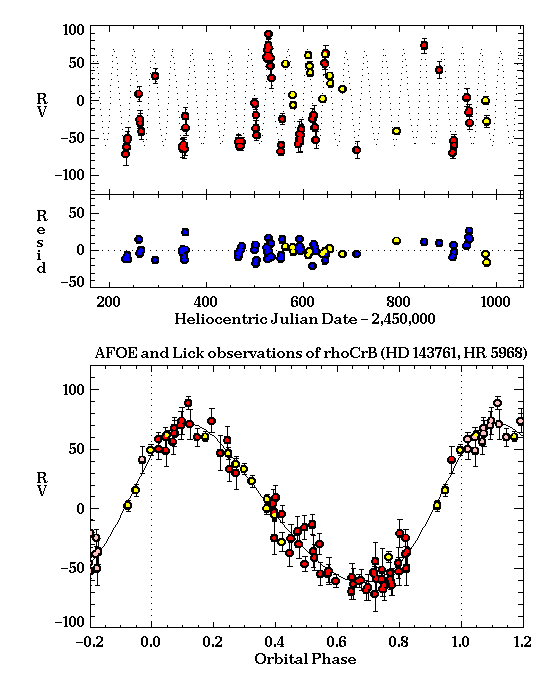 CrB
with the AFOE (Advanced Fiber Optic Echelle
spectrometer) show evidence of a planet orbiting the star
CrB
with the AFOE (Advanced Fiber Optic Echelle
spectrometer) show evidence of a planet orbiting the star  Coronae Borealis
(rhoCrB).
Coronae Borealis
(rhoCrB).
High precision radial velocity measurements of the starCrB with the AFOE (Advanced Fiber Optic Echelle spectrometer) show evidence of a planet orbiting the star
Coronae Borealis (rhoCrB).


All data points fit within a 3.0-sigma rejection criterion. The RMS of the residuals to the fit is 9.3 m/s.
For more details on these results, please refer to a recent poster
(700k postscript) presented
at the IAU Colloquium #170 (Noyes, et al.,
1998). The original announcements of
the discovery of the planet orbiting  CrB can be found in
Noyes, et al., 1997 ApJ. 483, L111 (and
487, L195).
CrB can be found in
Noyes, et al., 1997 ApJ. 483, L111 (and
487, L195).
 CrB
CrB Period: 39.90 +/- 0.08 days
K1: 66.68 +/- 3.00 m/s
e: 0.13 +/- 0.05
omega: 306.9 +/- 19.2 degrees (longitude of periastron)
T: 2,450,524.1 +/- 2.07 (time of periastron, HJD)
Chi^2: 1.31
RMS{resid}: 9.3 m/s
a1 sin(i): (36.28 +/- 0.87) x 1E+6 m
f1(m): (1.195 +/- 0.085) x 1E-9 M(Sun)
m2 sin(i): 1.11 M(Jup)
 CrB
CrB CrB is the star `rho' in the Corona Borealis
constellation (i.e., the Northern Crown).
The physical parameters of the star
CrB is the star `rho' in the Corona Borealis
constellation (i.e., the Northern Crown).
The physical parameters of the star  CrB are (from the scientific literature):
CrB are (from the scientific literature):
R.A.: 16:01:03.39
Dec.: +33:18:51.5 (2000.0)
Vis Mag.: 5.40
aka: HD 143761, HR 5968
Spectral Type: G0V or G2V
T(eff): ~ 5800 K
Parallax: 57.4 +/- 0.7 mas
Distance: 17.4 +/- 0.2 pc, or 56.8 +/- 0.7 ly
Luminosity: 1.77 L(Sun)
Age: ~ 10 Gyr
Mass: ~ 1.0 M(Sun)
P(rotation): ~ 20 d
log(g): ~ 4.2
Note also that G. Henry (1998, personal communication) reports that six years of precise photometric data for show no significant periodicities between 1 and 50 days, and constant seasonal means to within 0.00005 magnitudes. (Henry, Baliunas, Donahue, in prep.)
In situ formation of such a planet is unlikely (Lin and Ida 1997). It is more plausible that the planet formed at several AU from the parent star by means of gas accretion onto a rocky core, and then migrated inward. This could have happened by interactions with another giant gas planet which was ejected in the process (Weidenschilling and Marzari 1996), through interactions with the protoplanetary gas disk (Lin et al. 1996, Ward 1997, Trilling et al. 1998), or by interactions with planetessimals in mean-motion resonances (Murray et al. 1998). More observations--and new discoveries--of other planetary systems will help to address these possibilities.
 There is more on the AFOE's planet detection
program.
There is more on the AFOE's planet detection
program.
__________________________________________________